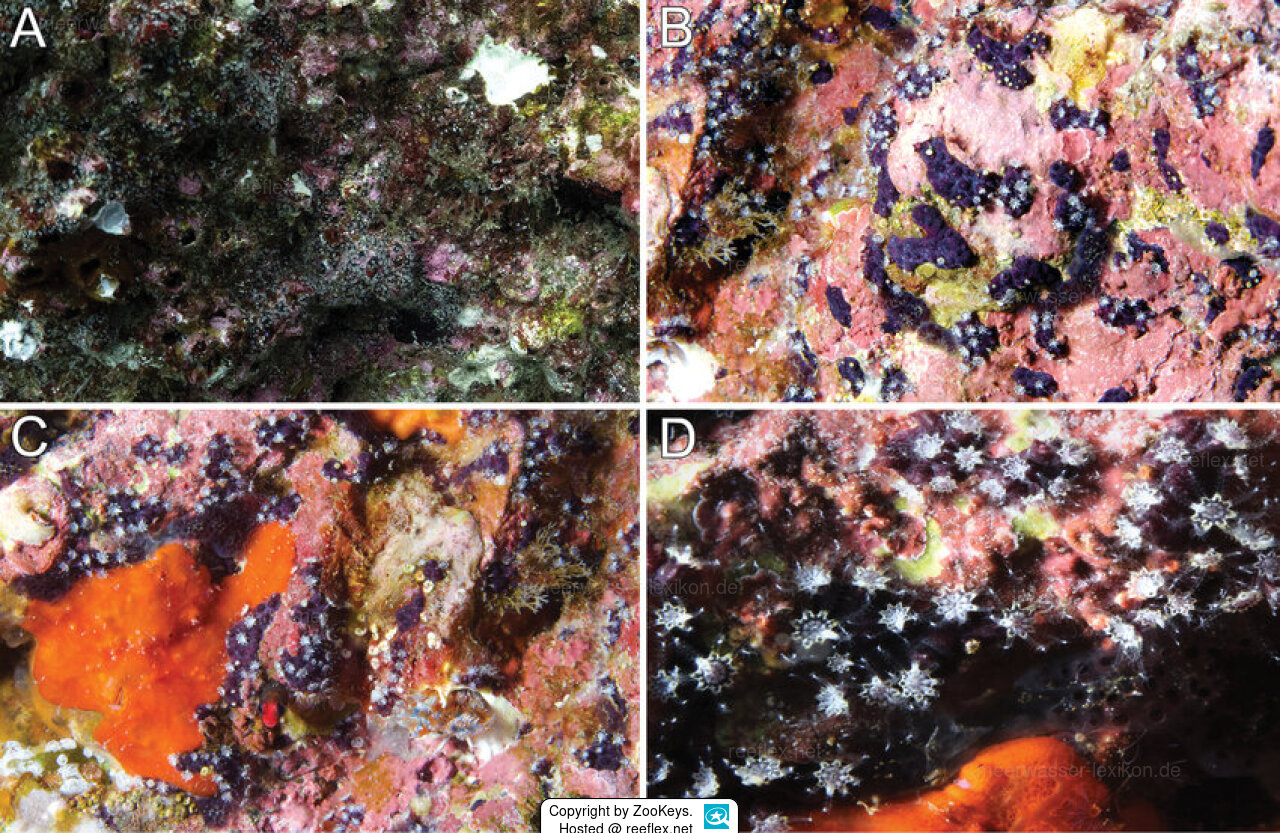Info
Aliena parva is an eight-rayed coral (Octocorallia) of the family Pterogorgiidae, found in various locations north of Isla del Cocob around Manuelita Afuera, Manuelita Canal and Bajo Manuelita, and northwest at Roca Sucia and Viking Rock (Isla Cáscara), NW of the island.
So far, this small coral is only known from the type locality of Cocos Island.
The colonies overgrow dead or living substrates, encrust small rocks, barnacle plates, shells or between peat.
They have often been found between the worm tubes of the endemic fish Acanthemblemaria atrata Hastings & Robertson, 1999 from Isla del Coco.
When the polyps are fully developed, the stomach cavities of the polyps protrude high above the polyp mounds and the oral disc extends into eight rays.
The holotype consists of 15 scattered tufts of polyps encrusting the surface of a barnacle about 4 cm in diameter, the barnacle plates are covered by many epibionts and several small, unbranched hydroids.
The polyps are arranged in clusters, have a length of 0.15-1.10 cm and consist of 3 - 20 polyps.
The polyps are retractable into calyces up to 0.75 mm in diameter and are transparent with yellow sclerites.
The colonies are dark red in life, the sclerites are usually dark red, but sometimes lighter in color.
Etymology:
The genus name "Parvus (L) , was chosen in allusion to the small size of the polyps. Gender Feminine: parva.
Etymology:
The species name "Alienus" means "foreign, strange, unrelated" and refers to the unexpected appearance or unnoticed presence of a new shallow-water taxon.
It also alludes to its surprising phylogenetic relationship with a group of gorgonians that was not predicted by morphology.
Sex female.
Literature reference:
Breedy O, McFadden CS, Cortés J (2023)
An enigmatic new octocoral species (Anthozoa, Octocorallia, Malacalcyonacea) from Isla del Coco National Park.
ZooKeys 1169: 317–331. https://doi. org/10.3897/zookeys.1169.100576
Copyright: © Odalisca Breedy et al.This is an open access article distributed under terms of the Creative Commons Attribution License (Attribution 4.0 International –CC BY 4.0)
So far, this small coral is only known from the type locality of Cocos Island.
The colonies overgrow dead or living substrates, encrust small rocks, barnacle plates, shells or between peat.
They have often been found between the worm tubes of the endemic fish Acanthemblemaria atrata Hastings & Robertson, 1999 from Isla del Coco.
When the polyps are fully developed, the stomach cavities of the polyps protrude high above the polyp mounds and the oral disc extends into eight rays.
The holotype consists of 15 scattered tufts of polyps encrusting the surface of a barnacle about 4 cm in diameter, the barnacle plates are covered by many epibionts and several small, unbranched hydroids.
The polyps are arranged in clusters, have a length of 0.15-1.10 cm and consist of 3 - 20 polyps.
The polyps are retractable into calyces up to 0.75 mm in diameter and are transparent with yellow sclerites.
The colonies are dark red in life, the sclerites are usually dark red, but sometimes lighter in color.
Etymology:
The genus name "Parvus (L) , was chosen in allusion to the small size of the polyps. Gender Feminine: parva.
Etymology:
The species name "Alienus" means "foreign, strange, unrelated" and refers to the unexpected appearance or unnoticed presence of a new shallow-water taxon.
It also alludes to its surprising phylogenetic relationship with a group of gorgonians that was not predicted by morphology.
Sex female.
Literature reference:
Breedy O, McFadden CS, Cortés J (2023)
An enigmatic new octocoral species (Anthozoa, Octocorallia, Malacalcyonacea) from Isla del Coco National Park.
ZooKeys 1169: 317–331. https://doi. org/10.3897/zookeys.1169.100576
Copyright: © Odalisca Breedy et al.This is an open access article distributed under terms of the Creative Commons Attribution License (Attribution 4.0 International –CC BY 4.0)







 ZooKeys
ZooKeys


